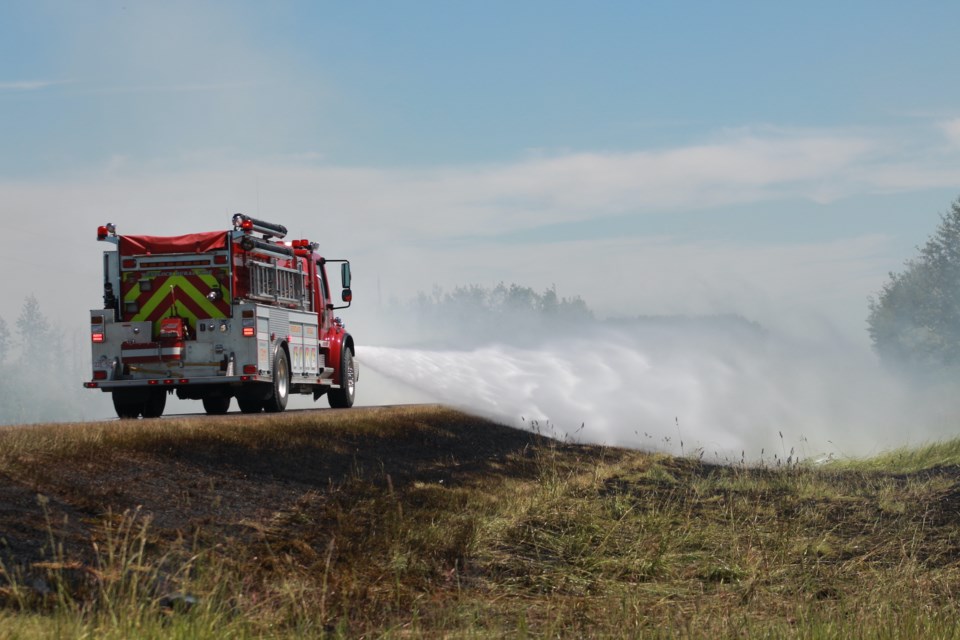WESTLOCK – Although spring 2023 is a little late in coming, Westlock County issued its annual wildfire advisory notice at the start of the month and crews were busy over the Easter long weekend with a pair of grassfires that nearly turned destructive.
County manager of protective services John Biro said via e-mail April 11 that firefighters were called to two separate grassfires that spread to buildings over Easter, but both were “actioned early” and only caused minor damage to the interiors.
That said, Biro said both “could have been prevented with the appropriate permits, supervision, and equipment.” His advice in preparation for the coming warmer weather is to re-visit any winter burn sites to ensure those fires have been completely extinguished and urges everyone to use extreme caution when working or driving in grassy areas, be mindful of hot exhaust and keep vehicles clean and free of debris as smoldering debris can lead to wildfires.
“Use extreme caution when using your burn barrels, even with the appropriate non-combustible base, barrel, and screen. Fire can and will get away with the right conditions present,” he said.
Biro goes on to note that many people aren’t aware that improperly extinguished fires can burn underground for months and resurface during hot, dry and windy days and quickly become an “out of control wildfire.”
When checking winter burn sites, spread any remaining debris so you can probe the area for hotspots and “use your bare hand to feel for heat over the ash piles.”
“If you see smoke or feel any heat, the fire is still burning beneath the surface. Douse any remaining hot spots with water and stir up the ashes. A fire is not completely extinguished until there is absolutely no heat emanating from the ashes.”
Currently, backyard fire pits, burn barrels, professionally-engineered incinerators, CSA approved or UL certified portable propane fire pits and wood fires in registered campground fire pits are all allowed, as are off-highway vehicles so long as they have proper sparks arrestors fitted. Exploding targets and tracer rounds are banned and any questions on the rules should be directed to the county.
Preventing wildland fires
The risk of wildland fires is high during the warmer months and forested areas and grasslands are of even greater concern if they’re near residential, industrial or agricultural developments.
And while most people know to be careful with matches and cigarettes and to follow safe burning practices when cleaning up garbage and debris, there are additional steps that homeowners in wildland or grassland settings can take to safeguard their homes.
First, Biro recommends contacting your insurance company to confirm you have the appropriate fire and wildfire coverage before it happens.
Next, clear the roof and gutters of needles and leaves and keep the area within 10 metres of buildings free of flammable vegetation as this “fuel-free zone” provides firefighters with a defensible space to assist in stopping a wildfire's spread.
Vegetation beyond the 10-metre defensible zone should be species that are less flammable like aspen, birch, poplar and the western larch. Meanwhile, firewood, combustible debris, wooden outbuildings and fences should all be at least 10 metres from buildings, while burning barrels, which must be screened and in good order to control sparks, should be at least 15 metres from buildings or flammable material.
Keep vegetation and combustible material away from propane tanks and contact your utility company to clear vegetation within a tree length of overhead power lines.
Also keep firefighting tools like a shovel, rake, sprinkler, roof-top ladder, and hose that reaches to the roof nearby and remember to check with local authorities before burning debris outside. If you do decide to burn brush, closely supervise the fire, keep a garden hose running nearby and keep children and pets far away from the area — always check with your county fire guardian to obtain information about burning regulations and permits.
Finally, always consider the prevailing wind direction and clearance from buildings and vehicles to avoid fire spread to valuable property — clear away all flammable and combustible materials for at least three meters around buildings or other flammable materials. Remember to establish a fire break between property lines and always keep a rake, shovel, water and extinguisher nearby.
If you require home/yard wildfire assessments, or require further assistance contact the county office and always report any suspicious activity or fires immediately.
|



